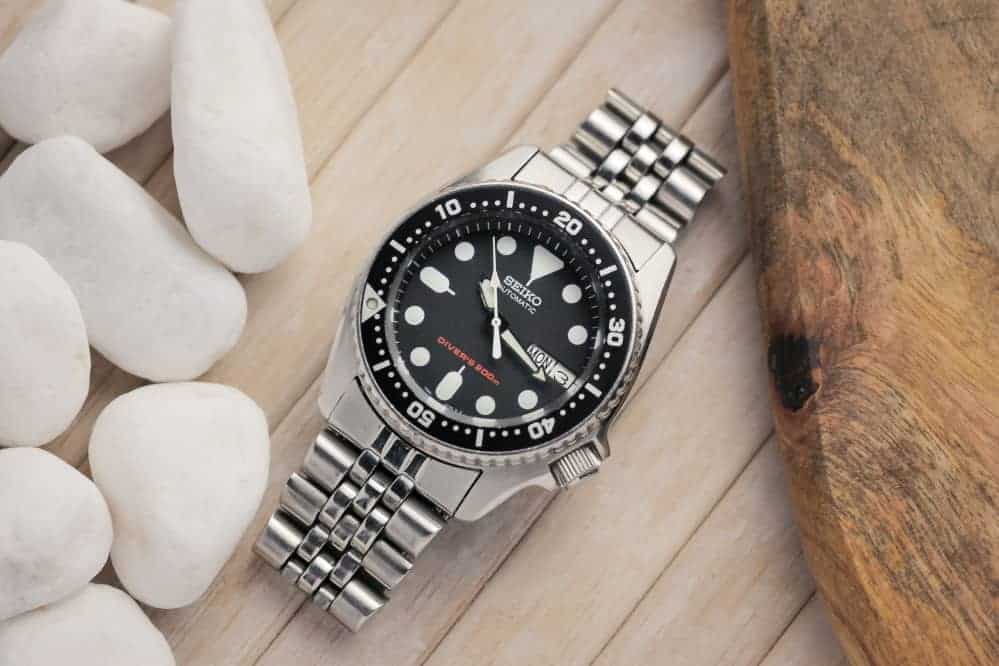Here are some practical tips for taking care of your dive watch.
Rinse with water
Don’t forget to rinse your watch with fresh water after each dive because salt water can corrode lugs and watch case back.
When rinsing your watch,
- rotate bezel to get rid of any debris, preventing salt residue, sand or coral fibers build up.
- gently shake your dive watch.
Although most new collections have shock resistance technology, shaking dive watch forcibly can damage the internal working of a watch. After rinsing, dry it of with soft towel.
Also if you have worn them in pool, rinse them thoroughly to get chlorine off because chlorine can accelerate the drying of gaskets. This in turn affects the water resistance of watch.
Based on the frequency of your dive or exposure of gaskets to chlorinated pool, you need to inspect the water resistance of watch every 12 to 36 months and change gaskets if needed.
(If you have bought your dive watch second hand, we suggest that you have it pressure tested by watch maker to determine the quality and strength of gasket.)
Although many people claim no visible damage on dive watches even after regularly swimming in chlorinated pool, rinsing is still a good preventive measure against potential long-term damage.
Avoid hot/cold temperature
Just as chlorinate water, heat has ill effect on watch. It causes metal parts and gasket to expand or contract. Here, crucial point to remember is that metal parts and gasket expand at different rate in hot temperature, creating small gaps. These gaps allow water droplets to enter inside the watch and damage it. Therefore it is not recommended to wear dive watch inside sauna or steam room or in hot tub.
Also,don’t expose your watch to sudden extreme temperature changes because it will cause condensation to form inside the watch. If not removed, condensation can corrode inner parts of the watch.
Beware of Magnetic Objects
Keep your watch at least more than 5 cm away from magnetic objects like handbag clasps, smartphones speaker, ac adapter etc because magnetism affects the movement of watch. Your watch may gain or loose time.
Push Down Crown
Before you get in water, always remember to either push down the crown or screwed it tightly. This is a common mistake committed by both rookie and seasoned collectors.
If you are already in water do not push down the crown or re-adjust or pull it. Such action creates the possibility of water penetrating the watch and ruining the movement. This can especially be problematic if you are diving deep where water pressure is high.
Don’t unscrew the crown immediately after emerging out from water. Let the watch dry out first because water can seep in if you pull(or unscrew) the crown while watch is still wet.
Although dive watches have gasket, screwing down crown will provide extra protection against water slipping inside the watch. Leaving it loose when diving can also damage the crown.
Avoid exposure to chemicals
Some of these household items can degrade and misshape gasket.
perfumes and hair sprays
it contains chemical that can diminish the quality of finishing of watch
soaps and shampoos
soap residue and shampoo can build up beneath bezel,making gasket dry and brittle faster
liquid cleaner
it can damage glass and deteriorate gasket
hand lotion and sunscreen lotion
it can leave stain on strap and damage gasket as well
aerosol cans
it can dry out gasket
Clean Your Watch
Regularly clean the exterior of your dive watch with toothbrush and microfiber cloth.Make sure that bristles of toothbrush are soft otherwise it can leave ugly scratches on the mineral crystal and steel of your dive watch.
For cleaning inside component of dive watch, it always best to take it to a professional.
Service Your Watch
You should service your watch at least every 5 years but if you wear it often or do lot of water activities wearing it, you might need to service it every 2-3 years. Another determining factor when it comes to watch servicing is, companies or watch maker recommendation. Every watch companies have their own timeline for servicing.
Understand Water Resistance of Your Watch
You should never wear your dive watch beyond the depth specified limit. Water resistance rating on the back case or dial of dive watch indicates how deep you can swim wearing it. Exceeding the limit will cause watch case to leak because it won’t be able to withstand the increasing pressure.
In theory dive watch labeled ‘Water resistance 200m’ should be fine at depth of 200m, you should however always swim to depth less than specified water resistance rating for the safety of your watch.
